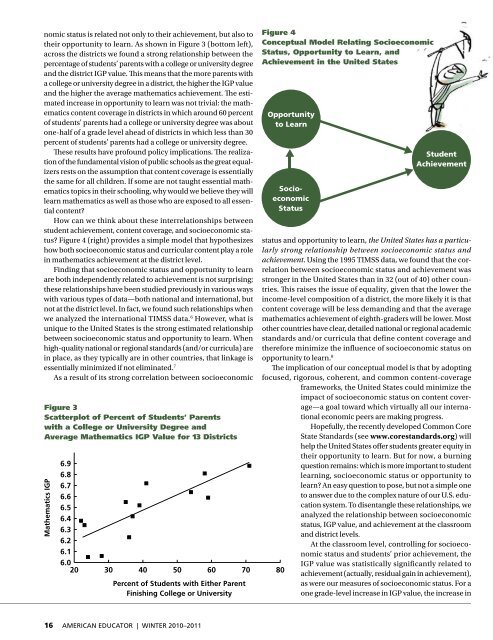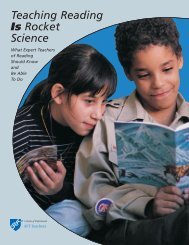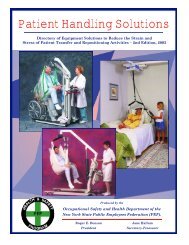American Educator, Winter 2010-11, Vol. 34, No. 4, AFT
American Educator, Winter 2010-11, Vol. 34, No. 4, AFT
American Educator, Winter 2010-11, Vol. 34, No. 4, AFT
Create successful ePaper yourself
Turn your PDF publications into a flip-book with our unique Google optimized e-Paper software.
nomic status is related not only to their achievement, but also to<br />
their opportunity to learn. As shown in Figure 3 (bottom left),<br />
across the districts we found a strong relationship between the<br />
percentage of students’ parents with a college or university degree<br />
and the district IGP value. Th is means that the more parents with<br />
a college or university degree in a district, the higher the IGP value<br />
and the higher the average mathematics achievement. Th e estimated<br />
increase in opportunity to learn was not trivial: the mathematics<br />
content coverage in districts in which around 60 percent<br />
of students’ parents had a college or university degree was about<br />
one-half of a grade level ahead of districts in which less than 30<br />
percent of students’ parents had a college or university degree.<br />
Th ese results have profound policy implications. Th e realization<br />
of the fundamental vision of public schools as the great equalizers<br />
rests on the assumption that content coverage is essentially<br />
the same for all children. If some are not taught essential mathematics<br />
topics in their schooling, why would we believe they will<br />
learn mathematics as well as those who are exposed to all essential<br />
content?<br />
How can we think about these interrelationships between<br />
student achievement, content coverage, and socioeconomic status?<br />
Figure 4 (right) provides a simple model that hypothesizes<br />
how both socioeconomic status and curricular content play a role<br />
in mathematics achievement at the district level.<br />
Finding that socioeconomic status and opportunity to learn<br />
are both independently related to achievement is not surprising;<br />
these relationships have been studied previously in various ways<br />
with various types of data—both national and international, but<br />
not at the district level. In fact, we found such relationships when<br />
we analyzed the international TIMSS data. 6 However, what is<br />
unique to the United States is the strong estimated relationship<br />
between socioeconomic status and opportunity to learn. When<br />
high-quality national or regional standards (and/or curricula) are<br />
in place, as they typically are in other countries, that linkage is<br />
essentially minimized if not eliminated. 7<br />
As a result of its strong correlation between socioeconomic<br />
Figure 3<br />
Scatterplot of Percent of Students’ Parents<br />
with a College or University Degree and<br />
Average Mathematics IGP Value for 13 Districts<br />
Mathematics IGP<br />
6.9<br />
6.8<br />
6.7<br />
6.6<br />
6.5<br />
6.4<br />
6.3<br />
6.2<br />
6.1<br />
6.0<br />
20 30 40 50 60 70 80<br />
Percent of Students with Either Parent<br />
Finishing College or University<br />
16 AMERICAN EDUCATOR | WINTER <strong>2010</strong>–20<strong>11</strong><br />
Figure 4<br />
Conceptual Model Relating Socioeconomic<br />
Status, Opportunity to Learn, and<br />
Achievement in the United States<br />
Opportunity<br />
to Learn<br />
Socioeconomic<br />
Status<br />
Student<br />
Achievement<br />
status and opportunity to learn, the United States has a particularly<br />
strong relationship between socioeconomic status and<br />
achievement. Using the 1995 TIMSS data, we found that the correlation<br />
between socioeconomic status and achievement was<br />
stronger in the United States than in 32 (out of 40) other countries.<br />
Th is raises the issue of equality, given that the lower the<br />
income-level composition of a district, the more likely it is that<br />
content coverage will be less demanding and that the average<br />
mathematics achievement of eighth-graders will be lower. Most<br />
other countries have clear, detailed national or regional academic<br />
standards and/or curricula that define content coverage and<br />
therefore minimize the infl uence of socioeconomic status on<br />
opportunity to learn. 8<br />
Th e implication of our conceptual model is that by adopting<br />
focused, rigorous, coherent, and common content-coverage<br />
frameworks, the United States could minimize the<br />
impact of socioeconomic status on content coverage—a<br />
goal toward which virtually all our international<br />
economic peers are making progress.<br />
Hopefully, the recently developed Common Core<br />
State Standards (see www.corestandards.org) will<br />
help the United States off er students greater equity in<br />
their opportunity to learn. But for now, a burning<br />
question remains: which is more important to student<br />
learning, socioeconomic status or opportunity to<br />
learn? An easy question to pose, but not a simple one<br />
to answer due to the complex nature of our U.S. education<br />
system. To disentangle these relationships, we<br />
analyzed the relationship between socioeconomic<br />
status, IGP value, and achievement at the classroom<br />
and district levels.<br />
At the classroom level, controlling for socioeconomic<br />
status and students’ prior achievement, the<br />
IGP value was statistically significantly related to<br />
achievement (actually, residual gain in achievement),<br />
as were our measures of socioeconomic status. For a<br />
one grade-level increase in IGP value, the increase in





